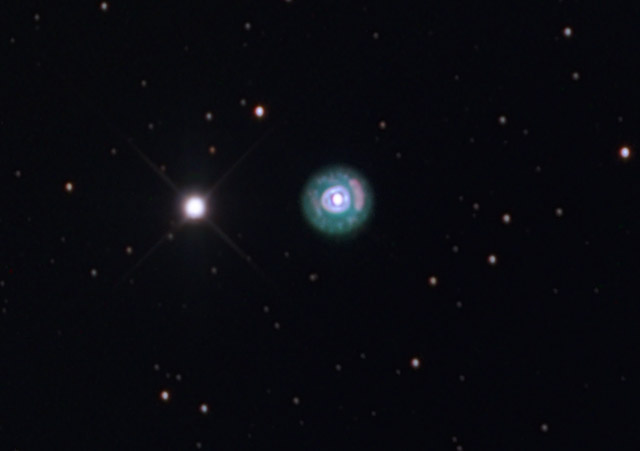NGC 2392
GEMINI - ESKIMO - MAGNITUDE 9.1

THE ESKIMO NEBULA
NGC
2392 - PLANETARY NEBULA IN GEMINI
One of the brighter planetary nebulae in the skies, NGC 2392 in Gemini is commonly called the "Eskimo" Nebula, and it's not difficult to see why. A planetary nebula is the result of a near dead star slowing shedding itself of its gases. The result is often a bright and colorful ring that encircles the star itself. Of course, the size of such nebula is rather small, somewhat resembling the size of a planet from our point of view. Hence, the term"planetary" is an apt classification.
The Eskimo is quite easy to see with even a modest scope and suburban skies. Despite its somewhat dim 9.1 apparent magnitude, like all planetaries it has a very high surface brightness. This means that there is a lot of contrast between the nebula and the sky background. NGC2392 is a favorite for many observers and can be found close to the twin stars of Gemini, Pollux and Castor.
Date:
February 28, 2005
Location: The Ballauer Observatory near Azle, Texas
Transparency: 4.2 mag zenithal
Seeing: 3/10
Temperature: 48 degrees F; camera cooled to -25 degrees C
Scope/Mount: 12.5" RCOS Ritchey-Chretien @ f/9 and Software
Bisque Paramount ME mount
Camera: SBIG STL-6303E, self-guided
Exposure Info: LRGB, 30:15:15:30 minutes; 10 minute
subexposures luminance and 5 minute subexposures for RGB unbinned.
Processing: Dark/flat frame calibration, registration,
gradient removal, hot pixel removal, and Average combine in MaxIm DL 4.
Digital Development and RGB combine in MaxIm DL 4. LRGB combine, deblooming,
color balance, curves, levels, selective sharpening/blurring/despeckle in
Photoshop CS.
Extra Notes: Poor seeing and slight wind affected the exposures. Subexposure times were too long resulting in an oversaturated central star in the nebula.
Astronomi Nebula Resimler Astrophotography Galaxy Resimler Yıldız Resimler
Copyright(c) 2003 - 2005 - Cetinbal - All rights reserved.